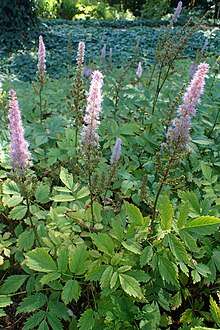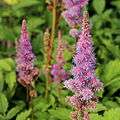Astilbe chinensis
Astilbe chinensis, commonly known as false goat's beard,[1] tall false-buck's-beard[2] or Chinese astilbe,[3] is a plant in the saxifrage family, Saxifragaceae. It is commonly grown in shade gardens.
| Chinese astilbe | |
|---|---|
 | |
| Scientific classification | |
| Kingdom: | Plantae |
| Clade: | Tracheophytes |
| Clade: | Angiosperms |
| Clade: | Eudicots |
| Order: | Saxifragales |
| Family: | Saxifragaceae |
| Genus: | Astilbe |
| Species: | A. chinensis |
| Binomial name | |
| Astilbe chinensis (Maxim.) Franch. & Sav. | |
Taxonomy
The binomial name of Chinese astilbe is Astilbe chinensis. The genus name, Astilbe, from the Greek words for "without" and "brightness", refers to the dullness of leaves of some species, while the specific epithet refers to the plant's Chinese origin.[3]
Chinese astilbe was originally described as Hoteia chinensis by C. J. Maximowiez in 1859. In 1875, Adrien René Franchet and Ludovic Savatier transferred it to the genus Astilbe.[4] Whether A. chinensis and A. rubra were distinct species or synonyms was a controversial issue for botanists throughout the 20th century,[4] with current consensus favoring the latter interpretation.[5] The plant once known as Astilbe davidii (Franch.) is today regarded as a variety of A. chinensis. Other varieties include A. chinensis var. divaricata (Nakai) and A. chinensis var. pumila (auct.).[5]
Description
Astilbe chinensis is a herbaceous perennial growing in clumps.[3] The species reaches a height of 45–90 centimetres (18–35 in).[4] The leaves are predominantly basal and ternately compound with sharply-toothed (often biserrated) leaflets. Most leaflets are elliptic to oval in shape and hairy. The mounds of leaves resemble ferns. Flowers are minuscule and form panicles on thin, erect or arching stems.[3]
Distribution
Chinese astilbe was discovered by Richard Maack on 6 July 1855 in the south of modern-day Amur Oblast of Russia and the Chinese region Heilongjiang, and by Leopold von Schrenck the following year.[4] The natural range of Chinese astilbe is Eastern China, Japanese archipelago, and Korea, at altitudes between 400 and 3600 meters. It is found along shaded streams and rivers as well as within and along the margins of damp, open broadleaf forests.[6]
Cultivation
Chinese astilbe is prized for its attractive foliage, plume-like inflorescence in the summer, and dried seed heads afterwards.[3] In 1902, the Journal of the Royal Horticultural Society described it as "the most important hardy perennial introduced during the past few years".[4] Chinese astilbe is usually planted in woodland gardens and shaded parts of herbaceous borders or cottage gardens as groundcover or edging plant. The plant requires partial to full shade, and grows best in soil which is well-drained and rich in organic material. While more tolerant of drought and exposure to direct sunlight than its congeners, the soil must never dry out. Generally resistant to pathogens and herbivores, most problems are caused by high temperatures and drought.[3]
The following cultivars have gained the Royal Horticultural Society's Award of Garden Merit:
Gallery
 Inflorescence
Inflorescence Dried seed heads
Dried seed heads- Mound
References
- English Names for Korean Native Plants (PDF). Pocheon: Korea National Arboretum. 2015. p. 385. ISBN 978-89-97450-98-5. Archived from the original (PDF) on 25 May 2017. Retrieved 25 January 2016 – via Korea Forest Service.
- "BSBI List 2007". Botanical Society of Britain and Ireland. Archived from the original (xls) on 25 January 2015. Retrieved 17 October 2014.
- "Astilbe chinensis 'Visions'". Missouri Botanical Garden. Archived from the original on 26 September 2013. Retrieved 12 April 2019.
- Lauener, L. A. (1996). The introduction of Chinese plants into Europe. SPB Academic Publications. p. 28.
- "Astilbe rubra Hook.f. & Thomson". The Plant List.
- "Astilbe chinensis – (Maxim.)Franch.&Sav". Plants for a Future.
- "RHS Plant Selector - Astilbe chinensis var. pumila". Retrieved 15 April 2020.
- "A. chinensis var. taqueti 'Purpulanze'". RHS. Retrieved 12 April 2020.
- "A. chinensis var. taqueti 'Superba'". RHS. Retrieved 12 April 2020.